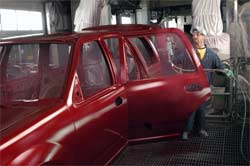Ford is leaving no particle unturned in the quest for fuel efficiency. Ford scientists are embracing the burgeoning fields of nanotechnology in developing paints, plastics, light metals and catalysts that allow Ford to reduce vehicle weight and improve fuel economy without sacrificing quality. Company researchers plan to outline key ways Ford is leveraging nanoparticles to improve automotive materials during this week's 2008 SAE World Congress in Detroit.
"Industry is becoming more efficient at creating nanoparticles," said Matthew Zaluzec, manager of the Materials Science and Nanotechnology Department for Ford Research and Advanced Engineering. "Our challenge is to take those nanoparticles, separate them and disperse them into existing materials in a way that makes our vehicles lighter, more durable, and more fuel efficient."
Ford has called out vehicle weight reduction as a key part of its strategy to improve fuel economy by 40 percent by 2020. The goal is reduce vehicle weight from 250 to 750 pounds -- depending on the model -- between 2012 and 2020 without compromising safety.
Ford powertrains already are benefiting from the company's grasp of nanotechnology and mircomechanical properties. A Ford study dubbed "Atoms to Engines" looked at the structure of cast aluminum alloys at near atomic levels. From this work, a detailed analysis of the structure/property/process relationship of the aluminum alloy engine blocks has led to reduced engine weight and, in turn, increased fuel efficiency.
"Many thought our aluminum engine technology was mature and fully optimized," Zaluzec said. "Not until we looked at every aspect of the materials and manufacturing process were we able to pull out another 10 percent in structural performance out of our engines, which directly translates into weight and fuel economy savings year over year. It's nano at the working level."
Modern engine blocks are partly made of cast iron or aluminum material whereas for the later hypo-eutectic AlSi-alloys dominate. Due to the low hardness, surfaces made of these alloys cannot be used as a friction partner for the piston rings. Cast iron liners are often inserted into the engine block to provide a wear-resistant surface for the piston rings. This work describes how cast iron liners can be replaced by thin, nanocrystalline iron based coatings in order to decrease friction losses as well as reduce the engine weight.
Ford's European research lab in Aachen, Germany, is developing a thermally sprayed nano-coating that could replace the heavier cast iron liners that provide the necessary wear resistance of cylinder bores in aluminum block engines. Presented at this year's SAE World Congress, this thin wear-resistant coating reduces weight and improves friction performance while delivering equal durability and reliability to the product.
Coatings in the way of vehicle exterior paint can benefit from Ford's nano-knowledge, too. Researchers are evaluating advanced surface coating applications that could enhance paint adhesion, appearance and durability.
"We want to take paint beyond what our customers are used to seeing on a vehicle," Zaluzec said. "We constantly ask questions like, can I change the functionality of a paint layer to give a unique appearance, to control heat dissipation or improve durability beyond what we've achieved to date?"
Nanotechnology also is being tapped by Ford scientists to help develop smarter solutions to energy storage issues for alternative power sources such as lithium-ion batteries and fuel cells.
Nanotechnology holds great promise in the auto industry. By 2015, experts predict nanomaterials will reach 70 percent usage in automotive applications.
Ford was one of the first automakers to apply nanotechnology to its products with the advent of today's catalytic converter. Ford has been active since the 1970s in exhaust catalysis and emissions controls, which are nano-based systems. Ford also was an early leader in the application of scanning probe microscopes, which allowed scientists to better view matter at a nano level.
In 2007, Ford bolstered its leadership in nano studies by forming an alliance with Boeing and Northwestern University in Evanston, Ill., one of the early leaders in the field of nanoscience and home to one of the first nanotechnology centers in the country.
The alliance, which was created to research commercial applications of nanotechnology, is producing promising results in the areas of specialty metals, plastic composites, thermal materials, coatings and sensors that could have large-scale uses across the transportation industry in the future.

